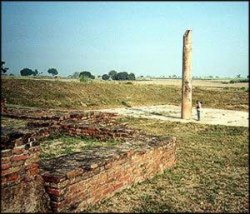Difference between revisions of "Kosambi"
Jump to navigation
Jump to search
| Line 1: | Line 1: | ||
[[File:Kosambi.jpg|thumb|250px|]] | [[File:Kosambi.jpg|thumb|250px|]] | ||
| − | [[Kosambi]] was a large city in {{Wiki|northern India}}, the {{Wiki|capital}} of the {{Wiki|kingdom}} of Vaṃsa and the scene of several important events in the [[life]] of the [[Buddha]]. The city was surrounded by walls nearly 6 kilometres long and faced the {{Wiki|Yamunā}} [[River]] on the south side. One of the [[monasteries]] built in [[Kosambi]] during the [[Buddha’s]] [[time]], the {{Wiki|Ghositārāma}}, was identified by archaeologists in 1951 and subsequently excavated. [[King]] [[Aśoka]] had a great pillar erected in the city and this can still be seen amongst the ruins. | + | [[Kosambi]] was a large city in {{Wiki|northern India}}, the {{Wiki|capital}} of the {{Wiki|kingdom}} of Vaṃsa and the scene of several important events in the [[life]] of the [[Buddha]]. The city was surrounded by walls nearly 6 kilometres long and faced the {{Wiki|Yamunā}} [[River]] on the {{Wiki|south}} side. One of the [[monasteries]] built in [[Kosambi]] during the [[Buddha’s]] [[time]], the {{Wiki|Ghositārāma}}, was identified by {{Wiki|archaeologists}} in 1951 and subsequently excavated. [[King]] [[Aśoka]] had a great pillar erected in the city and this can still be seen amongst the ruins. |
‘Excavations at Kausambi-1949-1950,’ Annual Bibliography of [[Indian]] Archaeology, 1969. | ‘Excavations at Kausambi-1949-1950,’ Annual Bibliography of [[Indian]] Archaeology, 1969. | ||
Latest revision as of 20:59, 19 September 2013
Kosambi was a large city in northern India, the capital of the kingdom of Vaṃsa and the scene of several important events in the life of the Buddha. The city was surrounded by walls nearly 6 kilometres long and faced the Yamunā River on the south side. One of the monasteries built in Kosambi during the Buddha’s time, the Ghositārāma, was identified by archaeologists in 1951 and subsequently excavated. King Aśoka had a great pillar erected in the city and this can still be seen amongst the ruins.
‘Excavations at Kausambi-1949-1950,’ Annual Bibliography of Indian Archaeology, 1969.
